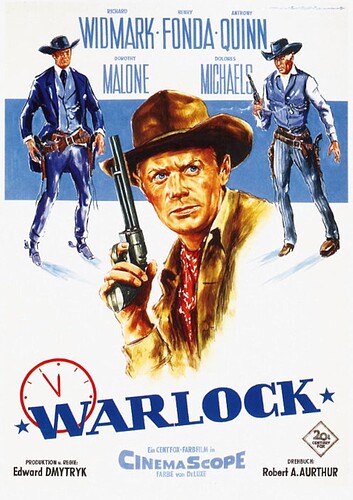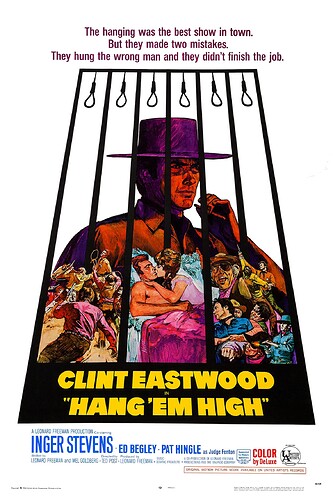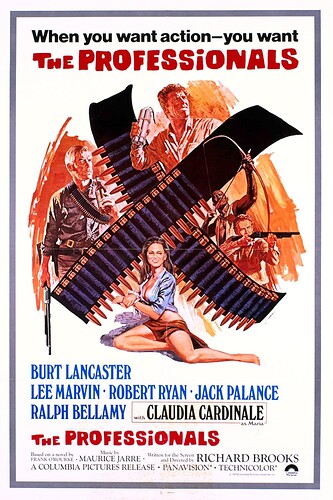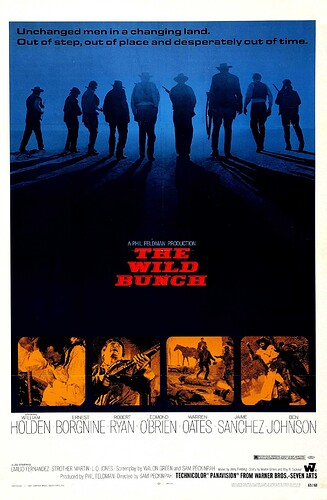Well at least we agree on this.
hahaha, sorry man - there’s just nothing interesting going on stylistically, it’s boring. Boone’s acting is great though.
I definitely agree. It’s like the director and screen writers didn’t know what to do with the story after building up tension between Janssen and Seberg. Like you, I thought Callahan had the SW look and feel down in the prison camp scenes.
After a rewatch 2 or 3 years ago I disagree.
Last Train from Gun Hill is a bit disappointing in view of what director, cast and plot are promising. Not bad of course, but for me it’s Sturges’ weakest western of the 50s. My former rating of 8/10 is now lowered to a solid 6/10.
I’ve only seen it once, and I liked it much more than Gunfight at the O.K. Corral. But I get where you’re coming from - its rewatch value is very low, as is the case with most 50s westerns. Westerns from that era tend to be a bit too generic and stylistically uninteresting to make me want to revisit them, unless I’ve completely forgotten what happened in the film. Even when they’re executed as well as Last Train from Gun Hill, they don’t really pull me back in. I might have overrated it a bit, but I was genuinely surprised by how much I liked it compared to other 50s westerns. So far, it’s my favorite from that decade.
I find there easily 100 better westerns in the 50s, and as I have watched most of them twice and more there seems to be a high rewatch value.
Gun Hill is a bit thin on characterisations, especially Quinn is mostly underused and underwritten (he often acts quite dumb). The film is too formulaic where it should instead trump with ideas. Again, that’s sad, as there was the potential for a great film.
It seems, and I said that before, you don’t understand the appeal of older westerns, otherwise you would understand at least why others love them, even if you don’t do so.
There is a reason why Ford and Hawks still belong to the most valued film directors. Imo they might be a bit overrated (there films have some general flaws), but I absolutely see what makes them fascinating. And Mann and Boetticher are also held high amongst film buffs. Not to mention others like Daves, Wellman, Walsh, Fuller, Ray or Aldrich. And of course also John Sturges.
Once again, to each their own, but I do understand the appeal of 50s Westerns. I believe it has more to do with the sensibilities and charm of the era than with genuine quality. I do enjoy 50s Westerns, even if they can be quite boring at times. They’re just not the movies I turn to when I’m looking for something truly compelling or stylistically interesting. 50s Westerns can be enjoyable, but they need to be approached with the right mindset.
There is a reason why Ford and Hawks still belong to the most valued film directors.
Yes, historic and cultural significance. Nothing more.
Once again, to each their own, but I do understand the appeal of 50s Westerns. I believe it has more to do with the sensibilities and charm of the era than with genuine quality. I do enjoy 50s Westerns, even if they can be quite boring at times. 50s Westerns can be enjoyable, but they need to be approached with the right mindset.
Yes, historic and cultural significance. Nothing more.
And I still think that you are completely wrong about that.
If they bore you, that’s ok, a matter of taste, but I know enough film and western fans who enjoy them not for what they are.
We’re just going to have to agree to disagree. It is matter of taste, since art is inherently subjective, but I don’t believe most 1950s American Westerns are genuinely good films. They’re similar to slasher movies, 80s American action films, or Marvel superhero movies - the vast majority of the genre isn’t made up of quality cinema, but people still enjoy these films for their charm and fun factor, and that’s perfectly fine. Ultimately, though, they’re popcorn flicks, not works of creative or stylistic significance, with some exceptions.
I haven’t said that they are genuinely good films, not the mass products of course, most have flaws, even the best, but that’s not different to SWs, of which even some of the best have considerable flaws (like Django or FoD).
And of course the majority of 50s westerns are just mediocre routine films, but just like for every other genre, the ones which are good are those which count, and there are many many which are good, and some are great. And some are film classics, however you or I or someone else views them.
Everything you say about them could also said about SWs, especially about SWs, and the US twilight westerns of the 60s/70s.
The western was and is a commercial genre, and even all the good examples are made mostly within the conflicts between commercial needs and individual style.
Whatever, it seems I see in 50s western much more style, individualism and even intelligence than you.
It is different to SWs since all the big SWs are creatively and stylistically significant… an Anthony Mann western like The Naked Spur or Man of The West though is mediocre in it’s entirety and has absolutely nothing creative or interesting about it. It’s as bland as mainstream cinema gets.
And of course the majority of 50s westerns are just mediocre routine films, but just like for every other genre, the ones which are good are those which count, and there are many many which are good, and some are great.
95% of them are mediocre, routine films. The few that stand out only do so because of a small fraction of the film. Shane, for example, has some genuinely strong moments and elements, but overall, it’s still not a very good film. Creatively and stylistically significant, yes, but ultimately a 6.5/10 and far from being a masterpiece…
And some are film classics, however you or I or someone else views them.
Films become classics for many reasons such as age and cultural significance, has little to do with the quality of the film itself.
Everything you say about them could also said about SWs, especially about SWs, and the US twilight westerns of the 60s/70s.
That’s not true - I can name plenty of Spaghetti Westerns and American Westerns from the 60s and 70s that are genuinely fantastic, even masterpieces. On the other hand, there aren’t any Westerns from the 50s that I’d consider masterpieces, and the vast majority of them aren’t even genuinely good.
The western was and is a commercial genre, and even all the good examples are made mostly within the conflicts between commercial needs and individual style
They were films that were cheap to produce so the directors and writers had plenty of freedom to follow their direction and vision for their film, especially after hays code was no more.
Interesting discussion. I’m more with @stanton on this one. The Fifties are probably my favorite western era, with directors like Ford, Hawks, Walsh, Aldrich, Sturges, Mann, Boetticher.
One remark drew my attention:
"It is different to SWs since all the big SWs are creatively and stylistically significant… "
In that case it would be interesting to know how many ‘big, creatively and stylistically significant’ SWs there are according to @hammerfist .
The SWs by Leone are, of course, and some of the best efforts by Corbucci are as well. Furthermore some SW directors like Sollima, Valerii or Petroni were good film makers, but were their movies stylistically that important? Most directors of Italian westerns just tried to ape the Leone style of gun duels and the ritual build-up to them, often with disastrous results, or they just tried to tell an action-filled revenge story, without thinking too much about style or creativity. I will always like spaghetti westerns, even the minor ones, mainly because they are ‘culturally significant’ to me as a movie lover (they were very popular when I was young and I loved them back them), not because they are so creative or stylish.
It’s important to keep in mind that the 1950s American Western is a genre and era much larger in terms of big productions when compared to SWs so it will naturally have more notable directors. In my opinion, Hawks has never made a single Western that is stylistically significant, and Mann is even worse - his films are as bland as they come. I haven’t seen enough of Boetticher to make a full judgment, but The Tall T was rather bland, and that’s considered one of his better ones. Sturges is the exception - I’ve always liked his films, and I think he was one of the first directors to make Westerns genuinely cool.
Ford really depends on the film, he was ridiculously inconsistent, and most of his quality output happened outside the 50s.
As you said, the most significant SW directors are primarily Leone and Corbucci. However, I’d argue that all the other Italian directors you mentioned have also made films that are creatively and stylistically significant. Maybe not important but certainly unique and they still hold up today. A film doesn’t have to be influential to be creative, stylistically distinct, or special. So yes, while their films might not be historically important, they still offer a lot of unique elements.
Take Petroni’s Death Rides a Horse - the plot is definitely a Leone imitation, but he brings so much of his own style to the execution. It’s fantastic. The Big Gundown also has a very unique plot and story, even if its execution is a bit conventional.
Warlock (1959) - A bog-standard Western that’s elevated by excellent performances from everyone involved - especially Henry Fonda, who is amazing here. It’s worth a watch for one of Fonda’s best performances, even if the writing isn’t anything special. - 6/10
Hang 'Em High (1968) [Rewatch] - An attempted American imitation of Leone’s Spaghetti Westerns. It has lots of unnecessary close-ups on people’s faces that actually detract from the film, as they’re used sloppily and without an understanding of what made them effective in Spaghetti Westerns. The soundtrack is enjoyable and features lots of Spaghetti Western elements. The plot is a standard American revenge Western, and the pacing feels very American in a bad way. However, Eastwood’s character is clearly based on the Man with No Name (though he’s much more morally righteous and clearly meant to be the good guy here) and some dialogue and scenes come off as blatant Leone worship. The film is nothing special, but not terrible either. - 6/10
The Professionals (1966) – This film starts off quite slowly, the first half hour or so is mostly setup. However, it picks up after that. It’s a classic “men on a mission” film, a format more commonly used in WWII settings (interestingly, most of those WWII films came out after this one) The cast is ok, filled with very commercial actors who aren’t particularly remarkable, with the exception of Jack Palance who delivers a fantastic performance - one of his best and Woody Strode who was a very underused actor, and is underused in this film as well. That said, everyone in the cast does a decent job.
The film’s strongest aspect is its aesthetic - arguably the best American Western set during the Mexican Revolution in terms of aesthetics. While much of the movie is not more than a 6/10, it has plenty of standout moments that elevate it. Overall, it balances out to being very good. - 7/10
The Wild Bunch (1969) [Rewatch] – My opinion on this film has changed over time. It’s one of those movies that gets better with every rewatch, and it’s now become my favorite American Western. It feels like an American interpretation of the hopelessly corrupt and morally bankrupt world of the Italian west. It’s also the most violent Western I’ve seen - more violent than any other. The action is uniquely chaotic, with rapid one to two second cuts that are intentionally disorienting, giving a sense of chaos to the action scenes.
It’s also the first American Western where the action sequences feel truly directed, with clear artistic intent. Something it shares with Spaghetti Westerns is the sense of purpose behind every element - the action, pacing, set pieces, characters, and story all feel carefully crafted. There’s no weak link, much like in a Leone film, or one of the better Corbucci films.
The film also incorporates elements strikingly similar to Leone’s style - such as the slow build-up to violence, close-ups on characters’ faces, and moral ambiguity - though these are executed in a way that’s uniquely Peckinpah’s. That said, the score and storytelling style are distinctly American. The narrative also relies heavily on dialogue, as opposed to being driven primarily through visuals like in many Italian Westerns. Still, I think Peckinpah was clearly influenced by the Dollars Trilogy here. - 9/10
A plea for friendship and comradeship, that even a lot of money becomes unimportant and you are willing to sacrifice your life for your friend. That is the message of this outstanding western by Sam Peckinpah, a masterpiece. 10/10
This week was El topo and Companeros.
Shoot First and Pray You Live (Because Luck Has Nothing to Do with It).
- American but clearly in the SW style.
It’s a pretty good low budget effort but a bit ‘talky’ and hardly wall-to-wall action.
The cast is full of faces that you recognise like John Doman (The Wire), Jim Gaffigan (the comedian and actor), Jeff Hephner (Chicago Fire) and
James Russo ( Bugsy in Sergio Leone’s ‘Once Upon a Time in America’).
Wikipedia says ‘’…if you have ever wondered what kind of movie would arise if you melded ‘Kill Bill’, ‘A Fistful of Dollars’ and ‘The Outlaw Josey Wales’ this movie is for you."
Considering some of the other non SW films listed on the Database I think there would be a place for this one.
Considering some of the other non SW films listed on the Database I think there would be a place for this one.
what exactly would be the reason to include this one? Style alone is not a reason.




